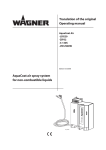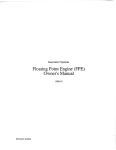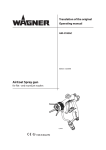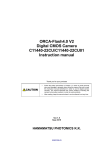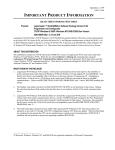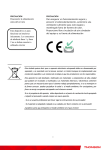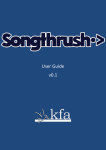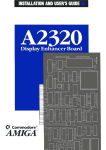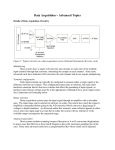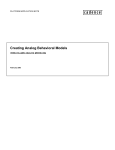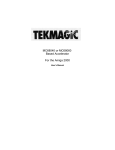Download 68040 Accelerator for the Amiga 2000 User Manual
Transcript
68040 Accelerator for the Amiga 2000 User Manual Progressive 040 / 2000 68040 Accelerator Card for the Amiga 2000 Hardware design by Tim Reese & John Meek Software by Michael W. Hartman & John W. Terrell Manual & Desktop Publishing by Roy E. Brothwell Edited by Sean A. Moore Commodore, Amiga, AmigaDOS & Workbench are trademarks of Commodore-Amiga, Inc. Video Toaster is a trademark of NewTek, Inc. Progressive 040 is a trademark of Progressive Peripherals & Software, Inc. Progressive 040 Hardware, Software & Manual ©1991 Progressive Peripherals & Software, Inc. All rights reserved. No part of this product may be reproduced in any form or by any means (including electronic store and retrieval or translation into a foreign language) without prior agreement and express written consent from Progressive Peripherals & Software, as governed by international and United States copyright laws. First Edition, August 1991 Printed in the U.S.A. Progressive 040 / 2000 Installation i Table Of Contents 1. Introduction 1.1. About the Motorola 68040 1.2. About the Progressive 040 Card 1.3. Software Compatibility Issues 1.4. Progressive 040 Utility Software 1.5 Glossary 1 1 2 2 2 3 2. Hardware Installation 2.1. The Danger of Static Electricity 2.2. Installation Procedure 4 4 4 3. Software Installation 7 4. Cache Operation 4.1. Instruction Cache 4.2. Data Cache 4.2.1. Write-Through Mode 4.2.2. Copyback Mode 9 9 9 10 10 5. Developing Software On and/or For the 68040 11 6. Configuring the Progressive 040 6.1. Power-up Configuration 6.1.1. Auto-Configure Memory 6.1.2. Processor Select 6.1.3. Cache 6.1.4. Burst 6.1.5. Motherboard Type 6.2. Adding Memory to the Progressive 040 6.2.1. About the Memory Chips 6.2.2. Installing the SIMMs 6.2.3. Setting the Memory Jumpers 13 13 14 15 16 16 16 17 17 18 19 7. Software Control of the Progressive 040/2000 21 8. Troubleshooting 22 ii Progressive 040 / 2000 Installation LIMITED 1-YEAR REPAIR WARRANTY and DISCLAIMER We warrant to you that for a period of 1 (one) year from the date of your original purchase, our product shall be free of defects in the material and workmanship. OUR WARRANTY EXTENDS TO THE ORIGINAL PURCHASER ONLY. If you discover a defect covered by this warranty, we agree to repair it at our expense, using new or remanufactured components at our sole discretion. PP&S’s liability is limited solely to the repair of the defective product. What you will need to do: To obtain free repairs under this warranty, you MUST deliver the product with its original sales receipt to PP&S. You will be responsible for paying any costs associated with the delivery to PP&S. PP&S will bear the cost of returning the product to you via the shipping method of PP&S’s choice. Costs of any other shipping method must be borne by you. Before returning the product, contact PP&S’s customer service department to obtain a Return Merchandise Authorization (RMA) number. No returns will be accepted unless the shipping label or outer box is clearly marked with the RMA number. What is not covered by this warranty: This warranty does not cover any damage or malfunction resulting from the improper handling, accident, abuse, misuse, failure of electrical power, use with or damage to other products used in conjunction, damage while in transit for repairs, repairs or modifications attempted by any unauthorized person or agency, or any other reason not due to defects in materials or workmanship. The warranty does not apply to and product having an altered, defaced, or missing serial number. The warranty does not cover any software or media, which are licensed or sold “as is”, without any warranties of any kind. Should such software fail to work or be unsuitable for your use, you must assume the full responsibility for service or replacement What PP&S will not be responsible for: We will not be liable to you or to anyone else for any liability, loss or damage for interruption of service, loss of business, data or anticipatory profits, or consequential, incidental or punitive damages resulting from the use (or operation) of the product purchased by you. IN NO EVENT WILL PP&S BE LIABLE FOR ANY AMOUNT IN EXCESS OF THE CURRENTLY SUGGESTED RETAIL PRICE OF THE PRODUCT. PP&S has no obligation nor assumes any responsibility for the enhancement or updating of any products you have purchased. DISCLAIMER THE ABOVE WARRANTY IS EXCLUSIVE AND IN LIEU OF ALL OTHER WARRANTIES, EXPRESS OR IMPLIED (OTHER THAN THOSE WARRANTIES IMPLIED BY STATE LAW.) ALL STATE STATUATORY IMPLIED WARRANTIES, INCLUDING, BUT NOT LIMITED TO IMPLIED WARRANTIES OF MERCHANTABILITY OR FITNESS FOR A PARTICULAR PURPOSE SHALL BE LIMITED TO A PERIOD OF 90 (NINETY) DAYS FROM THE DATE OF YOUR ORIGINAL PURCHASE. NO WARRANTIES, EITHER EXPRESS OR IMPLIED, WILL APPLY AFTER THIS PERIOD. Some states do not allow waivers, limitations or modifications of implied warranties, or the exclusion or limitation of incidental or consequential damages, so the above limitation or exclusion may not apply to you. This warranty gives you specific legal rights, and you may also have other rights which vary from state to state. Progressive 040 / 2000 Installation 1. Introduction Congratulations on your purchase of the Progressive 040 accelerator card for the Amiga 2000 computer. The Progressive 040 brings the high-speed processing power of the leading-edge Motorola® 68040 25MHz CPU to your Amiga™ 2000 computer. An A2000 equipped with the Progressive 040 will operate at 23 or more times its normal speed (up to 3 to 6 times faster than a 25MHz Amiga 3000). The Progressive 040 transforms an Amiga 2000 into a powerful workstation, with performance and capabilities previously found only in high-end workstations costing thousands of dollars more. For 3-D modeling, ray-tracing, multimedia applications, intensive multitasking, and any other processor-intensive work, the Progressive 040 produces results several times faster than previously possible. 1.1. About the Motorola 68040 Motorola rates the 68040’s performance at about 19.2 MIPS (Million Instructions Per Second) - faster than a SPARC 25MHz processor (19 MIPS), the R2000 RISC 20MHz processor (17 MIPS), a 68030 50 MHz processor (12 MIPS), and the Intel ‘486 processor. Raw floating point and integer operations are nearly twice as fast as a 50 MHz 68030. You won’t need to buy a separate math coprocessor - it’s built right in to the 68040 CPU! Performance analysis software, included on the disk, rates the Progressive 68040/A2000 at up to 35 times the speed of a standard Amiga 500. 1 2 Progressive 040 / 2000 Installation 1.2. About the Progressive 040 Card The Progressive 040 makes use of the 16-bit wide memory provided on the A2000 motherboard and in the A2000 expansion slots. In addition, up to 32 Megabytes of 32-bit memory can reside on the Progressive 040 card. The accelerator installs in the A2000’s processor slot next to the equipment platform, and the installation procedure is simple, requiring little time or technical skill. A low-profile 20+ year “whisper-fan” is mounted on the card to ensure reliable operation in even the most hostile climates. The Progressive 040 is compatible with both PAL and NTSC systems. 1.3. Software Compatibility Issues Compatibility with AmigaDOS™ release 2.0 and 2.0 compatible third party application software has been extensively tested for reliability and performance. However, incorrectly written software may not run on a 68040 accelerated Amiga. For these programs, we have provided a software “switch”, which allows you to toggle between the 68040 and 68000 processors. AmigaDOS™ 1.3 does not support the 68040’s advanced caching modes. Therefore, we recommend that AmigaDOS™ 2.0 be installed in ROM prior to installing the Progressive 040. 1.4. Progressive 040 Utility Software Additional software utilities enable and disable specific processor functions, such as instruction and data caching, copyback mode, and write-through mode. The utility disk also includes high performance floating-point software. Progressive 040 / 2000 Installation 1.5. Glossary Instruction Cache - A 4096 byte buffer inside the 68040 chip which speeds processing times by storing repeated instructions. The Instruction Cache can be turned ON or OFF by a number of available utilities. See Section 4 Cache Operation. Data Cache - A 4096 byte buffer inside the 68040 chip which speeds processing times by storing local data. The Data Cache can operate in either “Write-Through” or “Copyback” modes. The Data Cache can be turned ON or OFF, or placed in “Write-Through” or “Copyback” modes by a number of available utilities. See Section 4 Cache Operation. Copyback Mode - The Data Cache mode which holds local data in the cache and writes it to memory only when the cache is flushed or when the cache is full. See Section 4 Cache Operation. Write-Through Mode - The Data Cache mode which holds local data in the cache and keeps an up-to-date copy of the data in memory. See Section 4 Cache Operation. MIPS - Meaning “Millions of Instructions Per Second”, this term is often used to express the speed of a processor. 3 4 Progressive 040 / 2000 Installation 2. Hardware Installation The hardware installation procedure is not complicated, but it does require that you open your Amiga 2000 to gain access to its processor slot. If you are uncomfortable with this procedure, you may want to have a qualified Amiga technician install the Progressive 040 for you. 2.1. The Danger of Static Electricity The greatest potential for permanent damage to your Amiga 2000 or Progressive 040 comes from static electricity, even the smallest electrical discharge from you to an exposed computer chip can ruin the microcircuitry inside that chip. For this reason you should do everything possible to avoid static electricity and to ensure that you ground yourself each time you work with electronic parts. To reduce this danger, we suggest the following: • • • • Do not work on or near carpeting. Work at a table over a tiled, linoleum or concrete floor. Don’t wear clothes which attract static electricity (wool, nylon, polyester, etc.). Ground yourself each time you are about to pick up any electronic component. The hardware of a kitchen sink or the metal screw on a light switch are acceptable grounds. 2.2. Installation Procedure Prerequisite: The AmigaDOS 2.0 ROMs must be installed and tested prior to installing the Progressive 040 accelerator card. The Progressive 040 will not Progressive 040 / 2000 Installation operate properly if AmigaDOS 1.3 ROMs are installed in your Amiga 2000. If your Amiga 2000 is not equipped with AmigaDOS 2.0 ROMs, you can obtain a set from your local Amiga Dealer. You should perform the following procedure only after setting the Progressive 040’s power-up configuration and installing any additional memory. If you purchased the Progressive 040 populated with four or more megabytes of memory installed, your Progressive 040 is factory set to auto-configure the memory, boot the system using the 68040 processor, and enable both cache and burst modes. However, if you purchased the Progressive 040 with no memory installed, you will need to install at least four megabytes of 32-bit memory before the Progressive 040 will operate. The configuration procedure is covered in Section 6. of this manual. 1. Remove power from your Amiga 2000 and its peripherals. 2. Remove the four Phillips-head screws from the left and right sides and one Phillips-head screw from the center rear of the A2000. Gently slide the A2000 cover forward and up to remove it. 5 6 Progressive 040 / 2000 Installation 3. Locate the processor slot, nearest the equipment platform. If any power or data cables hinder you from inserting the Progressive 040 into this slot, note their current condition, then remove them. You will need to replace these cables once the Progressive 040 is in place. 4. Remove the two screws holding the processor slot cover in place at the rear of the A2000 chassis (retain these screws). 5. Firmly seat the Progressive 040 into the processor slot and secure the Progressive 040 to the rear of the A2000 chassis using the two screws retained from step 4. 6. Replace any power or data cables removed during step 3. Reconnect any peripheral equipment cables to the Amiga 2000. Note: We suggest that you test the Progressive 040 installation prior to replacing the A2000 cover so that you can make any jumper adjustments that may be necessary. 7. Reconnect all peripheral equipment and power up the A2000. Double-click on the CPU040 program icon (on the distribution disk) to verify that the A2000 is making use of the 68040 processor. If the 68040 processor is recognized by the system, the CPU040 program will run. If the 68040 processor is not recognized, a requester will appear telling you that a 68040 processor is required to run this program. If CPU040 still requests the 68040 processor, call PP&S Technical Services department at (303) 825-4144. Section 3 further describes the CPU040 program. Progressive 040 / 2000 Installation 3. Software Installation The Progressive 040 distribution disk contains several programs designed to help you manage and improve the performance of the 68040. AddMem - Running this program adds to the system any Progressive 040 memory not already configured. This command should be run before any other utility. The following entry should be entered into your “Startup-Sequence” prior to the “SetPatch” command entry. AddMem This will add all of the Progressive 040 memory into the system before making any other system patches. 68040.library - This library, provided by and licensed from Commodore Business Machines, is activated by the “SetPatch” command in your “Startup-Sequence”. The “68040.library” is similar to that shipped with Commodore’s ‘040 card, but it does not install the floating point emulation package. This library makes certain patches to the 2.0 operating system, optimizing it for the 68040 processor. To operate, “68040.library” must reside in your LIBS: directory. An installation program, “InstallLIB”, copies the “68040.library” to the current LIBS: directory for you. Double-click on the “InstallLib” icon to start the installation. You will be asked to confirm the installation by typing “Y” followed by a [Return], or abort the installation by typing a “N” followed by a [Return]. Alternatively, you can copy the “68040.library” to the LIBS: directory manually, using a disk utility program or the CLI. 7 8 Progressive 040 / 2000 Installation FastSys - Running this program copies certain system pointers and routines from their current location to the fastest Ram found in the system. Doing this increases the performance of the 68040, especially when performing floating point operations. Add the following command to your “Startup-Sequence”: FastSys This program should be run after the “AddMem” command to ensure that the fastest possible memory is available to the system. FP040 - The 68040 does not contain all of the instructions found on the 68881 and 68882. FP040 emulates these missing instructions. You can have the Amiga 2000 run this program automatically by placing it (with its icon) in the “WBStartup” drawer of your A2000. You can also run FP040 from the CLI or Startup-Sequence. Type the following command into an active CLI or Shell and press [Return], or insert it into your Startup-Sequence: Run FP040 CPU040 - Running this program allows you to quickly turn on/off Instruction cache, Data cache, Burst mode, or toggle between Write-through mode and Copyback mode, with the click of the mouse. Switch - This program allows you to toggle between the 68040 and 68000 processors. Double-click on the Switch program icon, then when prompted, reboot the A2000 by pressing the [Ctrl] + [Left Amiga] + [Right Amiga] key combination. Using this program, you can toggle from 68040 to 68000, or vice versa. SysInfo - This public domain program, written by Nic Wilson, provides information about the system software, available memory, available drives, and internal hardware. It also provides speed comparisons between your Amiga and other Amiga systems. Complete SysInfo documentation is on the distribution disk in file form. Progressive 040 / 2000 Installation 4. Cache Operation The 68040 processor contains a 4096 byte Instruction Cache and a separate 4096 byte Data Cache. Using the two caches to buffer information speeds code execution several times over. 4.1 Instruction Cache The instruction Cache works by holding groups of instructions that may be repeated, making them immediately accessible by the CPU. When the Instruction Cache is OFF, the CPU reads all of its instructions directly from memory. If groups of these instructions repeat, the CPU has to read them each time they repeat. However, when the Instruction Cache is ON, the 68040 holds the repeated instructions in its Instruction Cache, so that it doesn’t have to access the memory until new instructions are executed. If a program never repeats any instructions, having the Instruction Cache ON has no effect on processing speed. 4.2 Data Cache Like the Instruction Cache, the Data Cache holds information within the 68040 to avoid memory access whenever possible. The Data Cache can be OFF, or can be ON in one of two modes: Write-Through or Copyback. When the Data Cache is OFF, the CPU reads and writes all data directly from memory. However, when the Data Cache is ON, the 68040 holds local data in its Data Cache, allowing immediate access to the local data. The Data Cache may contain CPU modified data. At some time, the memory will have to be updated so that it contains the same data as the 9 10 Progressive 040 / 2000 Installation Data Cache. The Data Cache mode determines when the 68040 updates the memory with the modified data. 4.2.1 Write-Through Mode When the Data Cache is in Write-Through mode, the 68040 writes the data held in the Data Cache to memory during the next available memory bus cycle. The CPU can still operate on the data held in the Data Cache without waiting for it to be written to memory. This is the traditional Data Cache mode used by the 68030 processor. 4.2.2 Copyback Mode When the Data Cache is in Copyback mode, the ‘040 writes the data held in the Data Cache to memory only when information in the Data Cache needs to be replaced, or when the cache is flushed. The CPU may be working with the data held in the cache, modifying and re-working it. The 68040 doesn’t update the memory associated with the data held in the cache until absolutely necessary. By waiting for one of these conditions to occur before writing the data to memory, the memory is accessed as little as possible, speeding processing times. Progressive 040 / 2000 Installation 5. Developing Software On and/or For the 68040 Most code written for the 68000 processor will run on the 68040 as well. There is, however, some software that will not run properly. Programs that have selfmodifying code may not run when the Instruction Cache or Data Cache is ON. Any program which bypasses the operating system may not run when the Data Cache is in Copyback mode. You should follow the precautions below when writing software on the 68040: Don’t use the upper 8 bits of 68000 addresses to store tables. The 68040 uses all 32 bits of each address. Any program which uses the upper 8 bits of an address will most likely fail on a 68040. Base time dependent code on a system clock instead of the CPU speed. Since processors can have different clock speeds, a single timed operation will take different amounts of time when run on different processors, or processors running at different speeds. Test everything written on a 68040 based Amiga on a 68000 based Amiga. Code that runs properly on the 68040 may fail on a 68000 due to data word alignment. The 68000 requires word data on the stack to be word aligned, the 68040 does not. Some instructions exist only in the 68040. Be sure your compiler is not generating 68040 specific code if the program is to run on other processors as well. 11 12 Progressive 040 / 2000 Installation The 68040 FPU does not contain all the instructions found in the 68882 coprocessor. Code that makes use of these instructions will not run on the 68040 unless these instructions are emulated by the FP040 software (provided). These missing instructions are as follows: FACOS - Floating -Point Arc Cosine FASIN - Floating -Point Arc Sine FATAN - Floating -Point Arc Tangent FATANH - Floating -Point Hyperbolic Cosine FCOS - Floating -Point Cosine FCOSH - Floating -Point Hyperbolic Cosine FETOX - Floating -Point ex FETOXL - Floating -Point ex-1 FGETEXP - Floating -Point Get Exponent FGETMAN - Floating -Point Get Mantissa FINT - Floating -Point Integer Part FINTRZ - Floating -Point Integer Part, Round-to-Zero FLOG10 - Floating -Point Log10 FLOG2 - Floating -Point Log2 FLOGN - Floating -Point Loge FLOGNP1 - Floating -Point Loge (x+1) FSQRT - Floating -Point Square Root FMOD - Floating -Point Modulo Remainder FMPVECR - Floating -Point Move Constant ROM FREM - Floating -Point IEEE Remainder FSCALE - Floating -Point Scale Exponent FSGLDIV - Floating -Point Single Precision Divide FSFLMUL - Floating -Point Single Precision Multiply FSIN - Floating -Point Sine FSINCOS - Floating -Point Simultaneous Sine & Cosine FSINH - Floating -Point Hyperbolic Sine FTAN - Floating -Point Tangent FTANH - Floating -Point Hyperbolic Tangent FTENTOX - Floating -Point 10x FTWOTOX - Floating -Point 2x Progressive 040 / 2000 Installation 6. Configuring the Progressive 040 The three banks of jumpers at the top of the Progressive 040 card control several aspects of the Progressive 040’s operation. The jumper banks are labeled A, B, and C. Each pair of pins are numbered for easier identification. 6.1. Power-Up Configuration The Progressive 040 is factory configured to autoconfigure the 32-bit memory supplied with the card, boot the system using the 68040, and enable both cache and burst modes. Changing any of these settings requires that you move a jumper from one pair of pins to another pair of pins. The power-up settings are as follows: 13 14 Progressive 040 / 2000 Installation 6.1.1. Auto-Configure Memory (bank A positions 1 and 2, bank B position 3) A1 absent, A2 present, B3 present = Disabled A1 absent, A2 present, B3 absent = Configure 2MB * A1 present, A2 absent, B3 present = Configure 4MB A1 present, A2 absent, B3 absent = Configure 8MB * Recommended / Default Jumper Settings The 68000 processor can access up to 16 Megabytes of RAM directly, through RAM address lines. The Amiga can only access 9 MB of this RAM due to address line limitations. Standard 16-bit memory expansion cards, i.e. 8MB RAM cards, auto-configure their memory into this 16MB range. The Progressive 040 holds up to 32 Megabytes of 32-bit memory. Up to 8 MB (0, 2, 4, or 8 MB) of the Progressive 040 memory can be configured in the 68000 range. The remainder of the Progressive 040 memory must be configured above the 68000 range. The 68040 processor can access memory configured above the 68000 range faster than memory configured within the 68000 range. For best performance, we recommend that you autoconfigure only 2 Megabytes of the Progressive 040 memory into the 68000 range, and add the remainder of the Progressive 040 memory above the 68000 address range using the “AddMem” program (supplied). This will also allow up to 6 MB of 16-bit memory to be auto-configured from standard memory expansion cards. For instance, if you currently have an 8 MB memory expansion card, using the default configuration settings should auto-configure 2 MB of the Progressive 040 memory and 6 MB of the 8 MB card. Progressive 040 / 2000 Installation However, if the memory card manufacturer did not follow the auto-configuration standards, you may have to change the jumpers on the board to tell the Amiga that the card has 6 MB or less to configure. Check your memory board specifications for more information. Fully populating the Progressive 040 card (32 MB), it is possible to have a 41 MB Amiga (9 MB 16-bit memory and 32 MB 32-bit memory). This configuration will be slightly slower than auto-configuring 2 MB of the Progressive 040 memory, but it will allow you to use an additional 2 MB of 16-bit memory. 4MB Users: You must configure at least 2 MB of the Progressive 040 memory above the normal 68000 address range. Failure to do so will cause a hardware conflict, and the Progressive 040 will not run. Note: The one Megabyte of “chip” ram on the motherboard is always configured. 6.1.2. Processor Select (bank A positions 3 and 4) A3 absent, A4 present = Boot 68040 (default) A3 present, A4 absent = Boot 68000 You will almost always want to boot your system using the 68040 processor. The only exception to this is during testing, or when running software that is incompatible with the 68040. The “Switch” program (provided) will also allow you to toggle between the two processors without changing this jumper. When booting in 68000 mode, the specified amount of Progressive 040 memory will still auto-configure into the system. 15 16 Progressive 040 / 2000 Installation 6.1.3. Cache (bank C positions 1 and 2) C1 absent, C2 present = Enabled (default) C1 present, C2 absent = Disabled You will almost always want to have caching enabled. The 68040’s caching features provide a major boost in processing speed. You may, however, want to disable caching for hardware testing purposes. Normally, you will want to disable/enable the cache using the CPU040 program (provided). 6.1.4. Burst (bank C positions 3 and 4) C3 absent, C4 present = Enabled (default) C3 present, C4 absent = Disabled You will almost always want to have Burst mode enabled. You may, however, want to disable bursting for software testing purposes. The CPU040 program allows you to disable/enable bursting without changing this jumper setting. 6.1.5. Motherboard type (bank B position 4) B4 absent = B2000 motherboard (default) B4 present = A2000 motherboard Most A2000s are of the “B2000” type motherboard. However, some of the older “A2000” type motherboards are still in service. To determine whether your Amiga 2000 is of the “A2000” type or “B2000” type, look at the lower left-hand corner of the motherboard just below the copyright notice. Progressive 040 / 2000 Installation 6.2. Adding Memory to the Progressive 040 The Progressive 040 can be purchased with 0, 4, 8, 16, or 32 Megabytes of 32-bit memory factory installed. In all but the zero megabyte configuration, the Progressive 040 is already configured and can be installed without changing any of the jumpers. The Progressive 040 requires at least four megabytes of memory to operate. 6.2.1. About the Memory Chips The Progressive 040 accepts 30-pin SIMMs (Single Inline Memory Module) in one megabyte packages (1Meg x 8 DRAM - 80 nanosecond) and in four megabyte packages (4 Meg x 8 DRAM - 80 nanosecond). The memory may be any of the common types: Fast page (recommended), Static column, or Nibble. A minimum of four SIMMs are required on the Progressive 040 card. You cannot mix 1 meg and 4 meg SIMMs! Only one type of SIMMs can reside on the Progressive 040. Therefore, if you use 1 Meg SIMMs, the Progressive 040 can be populated to four megabytes or eight megabytes. If you use 4 Meg SIMMs, the Progressive 040 can be populated to sixteen megabytes or thirtytwo megabytes. Note: If you plan to populate the Progressive 040 with thirty-two megabytes of memory in the future, you should use 4 Meg SIMMs in your initial memory configuration instead of 1 Meg SIMMs. Any 1 Meg SIMMs on the card will eventually have to be replaced with 4 Meg SIMMs. 17 18 Progressive 040 / 2000 Installation 6.2.2. Installing the SIMMs After acquiring the desired type and amount of memory you will need to insert it into the SIMM sockets toward the rear of the Progressive 040 card. If you are installing four megabytes (four 1Meg x 8 chips) or sixteen megabytes (four 4Meg x 8 chips), you must install them into the “Bank 1” sockets (see illustration above). If you are installing eight or thirtytwo megabytes of memory, you will be using all of the sockets. The SIMMs fit into the sockets at an angle, with the chip side of the SIMM facing away from the Progressive 040 card. Gently and evenly insert the SIMM into the socket until the two hooks catch the holes on either side of the SIMM. These hooks lock the SIMM into place, preventing accidental removal. Progressive 040 / 2000 Installation Repeat this procedure for every SIMM to be installed. The table below shows the type and quantity of SIMMs needed and the banks used for each memory configuration. Memory Amount 4 Megabytes 8 Megabytes 16Megabytes 32Megabytes Banks 1 only 1&2 1 only 1&2 Memory Type 1Meg x 8 - 80ns 1Meg x 8 - 80ns 4Meg x 8 - 80ns 4Meg x 8 - 80ns Quantity 4 SIMMs 8 SIMMs 4 SIMMs 8 SIMMs If you are replacing previously installed SIMMs with SIMMs of another type, remove the SIMM by gently prying one hook out of its hole and slightly lifting that side of the SIMM. Repeat this on the other hook so that neither hook is holding the SIMM in place. Gently pull the SIMM out of the socket. 6.2.3. Setting the Memory Jumpers After installing the memory, you must tell the Progressive 040 about the installation. 19 20 Progressive 040 / 2000 Installation 6.2.3.1. Non-nibble mode DRAMs (bank B position 1) B1 present = Fast page or Static column DRAM B1 absent = Nibble mode DRAM This jumper tells the Progressive 040 whether the memory chips installed are nibble mode DRAMs (Dynamic Random Access Memory). Most memory sold in SIMMs are of the Fast Page type or of the Static Column type. If you are unsure as to the type of memory you have purchased, you may set the jumpers for nibble mode DRAMs. This setting will allow all types of memory to operate. 6.2.3.2. SIMM Configuration (bank B position 2) B2 present = 1Meg x 8 - 80ns DRAM B2 absent = 4Meg x 8 - 80ns DRAM This jumper tells the Progressive 040 which SIMM configuration you are using. Remember that you cannot mix 1 Meg SIMMs with 4 Meg SIMMs. Progressive 040 / 2000 Installation 7. Software Control of the Progressive 040/2000 Three of the jumper settings listed in Section 6.1. are software programmable. These are Cache Enable, Burst Enable, and Processor Select. The power-up settings are used to set the values to a known (most commonly used) state. These values may be changed under software control at any time. It is important to note, however, that a change to the Processor Select bit does not take effect until after a re-boot. The address of the port and the register values are given below: PORT ADDRESS: DATA: D3 D2 D0* 0xE90000 0xE90002 0xE90003 (RW) Hardware Cache Enable (RW) Burst Enable (RW) Processor Select (Long Word) (Word) (Byte) (1 = Off, 0 = On) (1 = Off, 0 = On) (1 = 68000, 0 = 68040) * If written, the change will not take place until the machine is soft-reset. 21 22 Progressive 040 / 2000 Installation 8. Troubleshooting Most problems that arise while installing the Progressive 040 are associated with Progressive 040 jumper configuration, ROM installation, or A2000 reassembly. If you purchased the Progressive 040 with memory installed at the factory, the proper configuration has been performed at the factory. However, it is still wise to check the configuration against the manual prior to installing the Progressive 040. If you install the 2.0 ROMs just prior to installing the Progressive 040, be sure to test the ROM installation. If the 2.0 ROMs are not properly installed, the A2000 won’t boot. When disassembling the A2000, take note of which cables are connected and where. All equipment cables will have to be restored to their original positions upon reassembly. If any of the equipment cables are not properly reconnected, the A2000 may not operate. Also, be sure to firmly seat the Progressive 040 card connector into the Processor Slot and secure the Progressive 040 in place using the two screws which previously secured the processor card cover. If after taking these precautions and re-checking the installation, you are still having problems, call PP&S Technical Services at (303) 825-4144. Progressive 040 / 2000 Installation Note: The Progressive 040 has been tested with several hardware peripherals including hard drive controllers and video products. The Progressive 040 has been found to work with the following: Commodore 2091 Hard Disk Controller Advanced Storage Systems - Nexus 8MB Hard Disk Controller (A Division of Preferred Technologies, Inc.) GVP Series II Hard Disk Controllers with the FAAASTROM Option (Great Valley Products) The Progressive 040 has been found not to work with the following: Commodore 2090 and 2090A Hard Disk Controllers GVP Series II Hard Disk Controllers (Version 1.0 ROM) Microbotics Hard Frame Controller Note: Product compatibility is subject to change without notice. 23 Amiga Hardware World Everything about Amiga hardware... ~ http://amiga.resource.cx
































